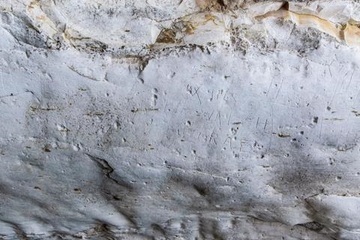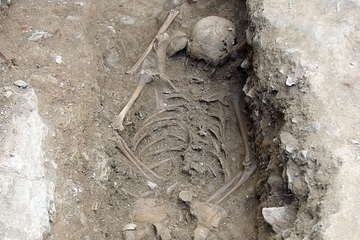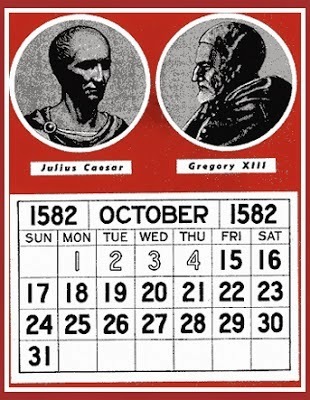MaryAnn Bernal's Blog, page 231
October 7, 2014
1,900-Year-Old Ritual Bath Found Defaced by World War II Graffiti
By Kelly Dickerson

During World War Two, soldiers scrawled a message across the ceiling of an ancient water cistern.
Credit: Assaf Peretz/IAA
Archaeologists recently unearthed an ancient Jewish ritual bath defaced with World War II-era graffiti.
The Israel Antiquities Authority (IAA) discovered a 1,900-year-old ritual bath (called a "miqwe" or mikveh) and a 1,700-year-old water cistern at the Ha'Ela Junction of Highway 38 in Israel while a construction project to widen the major thoroughfare was underway.
But archaeologists were surprised to discover that the ancient artifacts had been defaced — Australian World War II soldiers had etched graffiti into the exposed ceiling of the water cistern. [The Holy Land: 7 Amazing Archaeological Finds]
"The finds from this excavation allow us to reconstruct a double story —about the Jewish settlement in the second century C.E. [Christian Era, or A.D.], probably against the background of the events of the Bar Kokhba revolt, and another story, no less fascinating, about a group of Australian soldiers who visited the site [about] 1,700 years later and left their mark there," Yoav Tsur, excavation director for the IAA,said in a statement.
Assaf Peretz, an archaeologist at the IAA, deciphered the graffiti scrawled across the ceiling of the cistern. The message was signed "Cpl Scarlett and Walsh," with the initials "RAE," two numbers and the date "30/05/1940."
Peretz and the other archaeologists then had to do a little detective work to figure out the identities of Scarlett and Walsh. "Cpl" stands for the military rank "corporal," and the initials "RAE" represent the Royal Australian Engineers, the researchers said. The two numbers were found to be soldier serial numbers, and they allowed the archaeologists to identify the two graffiti artists as Cpl. Philip William Scarlett and Patrick Raphael Walsh.
Scarlett and Walsh belonged to the Sixth Division of the Australian Army and were training in the area before their scheduled deployment to fight on the frontlines in France. However, France surrendered before the division's ship date, so Scarlett and Walsh were sent to Egypt instead in October 1940 to fight in the Western Desert, located west of the Nile Valley. Both men survived World War II; Scarlett died in 1970, at age 51, and Walsh died in 2005, at age 95.
"If the relatives of these people are acquainted with the story, we'll be happy if they contact us, and we'll share with them the warm greetings left behind by Scarlett and Walsh," Peretz said in a statement.
The ancient ritual bath has five steps, and the top step acted as a bench where people could sit at the edge of the pool, Tsur said. Archaeologists also found pots and jugs scattered around the bath. The IAA suspects the ritual bath stopped being used in the early second century A.D., after the Bar Kokhba revolt, which was the last battle that pitted the Jews against their persecutors in the Roman Empire.
The huge water cistern where the graffiti was found used to feed the nearby ritual bath. After the bath stopped being used, people likely enlarged the cistern's cavity and used it as a water vat, according to the archaeologists.
During construction projects in this region, it's fairly common to uncover ancient artifacts. Several archaeological sites already exist alongside Highway 38, which connects Judea to the city of Beit Shemesh. In November 2013, construction along the highway revealed a 10,000-year-old house. Other construction projects this year have uncovered a 6th-century monastery and a hoard of bronze coins that date back to the Great Revolt, a Jewish uprising against the Romans about 2,000 years ago.
The construction company working on widening the highway has agreed to preserve the site of the ancient ritual bath and will incorporate it as part of the natural landscape alongside the road, the archaeologists said.
Live Sciencel


During World War Two, soldiers scrawled a message across the ceiling of an ancient water cistern.
Credit: Assaf Peretz/IAA
Archaeologists recently unearthed an ancient Jewish ritual bath defaced with World War II-era graffiti.
The Israel Antiquities Authority (IAA) discovered a 1,900-year-old ritual bath (called a "miqwe" or mikveh) and a 1,700-year-old water cistern at the Ha'Ela Junction of Highway 38 in Israel while a construction project to widen the major thoroughfare was underway.
But archaeologists were surprised to discover that the ancient artifacts had been defaced — Australian World War II soldiers had etched graffiti into the exposed ceiling of the water cistern. [The Holy Land: 7 Amazing Archaeological Finds]
"The finds from this excavation allow us to reconstruct a double story —about the Jewish settlement in the second century C.E. [Christian Era, or A.D.], probably against the background of the events of the Bar Kokhba revolt, and another story, no less fascinating, about a group of Australian soldiers who visited the site [about] 1,700 years later and left their mark there," Yoav Tsur, excavation director for the IAA,said in a statement.
Assaf Peretz, an archaeologist at the IAA, deciphered the graffiti scrawled across the ceiling of the cistern. The message was signed "Cpl Scarlett and Walsh," with the initials "RAE," two numbers and the date "30/05/1940."
Peretz and the other archaeologists then had to do a little detective work to figure out the identities of Scarlett and Walsh. "Cpl" stands for the military rank "corporal," and the initials "RAE" represent the Royal Australian Engineers, the researchers said. The two numbers were found to be soldier serial numbers, and they allowed the archaeologists to identify the two graffiti artists as Cpl. Philip William Scarlett and Patrick Raphael Walsh.
Scarlett and Walsh belonged to the Sixth Division of the Australian Army and were training in the area before their scheduled deployment to fight on the frontlines in France. However, France surrendered before the division's ship date, so Scarlett and Walsh were sent to Egypt instead in October 1940 to fight in the Western Desert, located west of the Nile Valley. Both men survived World War II; Scarlett died in 1970, at age 51, and Walsh died in 2005, at age 95.
"If the relatives of these people are acquainted with the story, we'll be happy if they contact us, and we'll share with them the warm greetings left behind by Scarlett and Walsh," Peretz said in a statement.
The ancient ritual bath has five steps, and the top step acted as a bench where people could sit at the edge of the pool, Tsur said. Archaeologists also found pots and jugs scattered around the bath. The IAA suspects the ritual bath stopped being used in the early second century A.D., after the Bar Kokhba revolt, which was the last battle that pitted the Jews against their persecutors in the Roman Empire.
The huge water cistern where the graffiti was found used to feed the nearby ritual bath. After the bath stopped being used, people likely enlarged the cistern's cavity and used it as a water vat, according to the archaeologists.
During construction projects in this region, it's fairly common to uncover ancient artifacts. Several archaeological sites already exist alongside Highway 38, which connects Judea to the city of Beit Shemesh. In November 2013, construction along the highway revealed a 10,000-year-old house. Other construction projects this year have uncovered a 6th-century monastery and a hoard of bronze coins that date back to the Great Revolt, a Jewish uprising against the Romans about 2,000 years ago.
The construction company working on widening the highway has agreed to preserve the site of the ancient ritual bath and will incorporate it as part of the natural landscape alongside the road, the archaeologists said.
Live Sciencel

Published on October 07, 2014 12:37
Skeleton of Possible 'Witch Girl' Found
By Rossella Lorenzi

Credit: Stefano Roascio
An archaeological dig in northern Italy has unearthed the remains of a 13-year-old-girl buried facedown -- evidence, archaeologists say, that despite her young age, she was rejected by her community and seen as a danger even when dead.
Dubbed by Italian media as “the witch girl,” the skeleton was unearthed at the complex of San Calocero in Albenga on the Ligurian Riviera, by a team of the Pontifical Institute of Christian Archaeology at the Vatican.
The site, a burial ground on which a martyr church dedicated to San Calocero was built around the fifth and sixth centuries A.D., was completely abandoned in 1593.
The prone burial, which has yet to be radiocarbon dated, is thought to date from the late antiquity or the early Middle Ages.
“These rare burials are explained as an act of punishment. What the dead had done was not accepted by the community,” said Stefano Roascio, the excavation director. Like other deviant burials, in which the dead were buried with a brick in the mouth, nailed or staked to the ground, or even decapitated and dismembered, the facedown treatment aimed to humiliate the dead and impede the individual from rising from the grave.
“In particular, the prone burial was linked to the belief that the soul left the body through the mouth. Burying the dead facedown was a way to prevent the impure soul threatening the living,” anthropologist Elena Dellù told Discovery News.
In extreme cases, a facedown burial was used as the ultimate punishment, with the victim horrifically buried alive.
BLOG: Skeletons Shed Light On Ancient Earthquake In IsraelIt wasn’t a treatment used on the teenage girl, however.
“The skeleton’s position rules out this possibility,” Dellù said.
Found with her hands placed on the pelvis and straight and parallel legs, the girl showed no apparent signs of a violent death in her bones. However, Dellù noticed porotic hyperostosis on the skull and orbits. These areas of spongy or porous bone tissue are the result of a severe anaemia.
“She could have suffered from an inherited blood disorder such as thalassemia or from hemorrhagic conditions. More simply, it could have been an iron lacking diet,” Dellù said.
PHOTOS: Ancient Quake Revealed By Remains Standing just under 5 feet tall, the young girl somehow scared the community -- perhaps it was just her pallor, her possible hematomas and fainting.
Intriguingly, her disrespectful burial was found in a privileged area, just in front of the church.
“This makes the finding even more unusual. A similar case of a teenager buried facedown in front of a church was found at the archaeological site of Pava near Siena,” Roascio told Discovery News.
“A precise dating of the skeleton and further research on similar burials might help in finding more clues,” Roascio said.
Live Science


Credit: Stefano Roascio
An archaeological dig in northern Italy has unearthed the remains of a 13-year-old-girl buried facedown -- evidence, archaeologists say, that despite her young age, she was rejected by her community and seen as a danger even when dead.
Dubbed by Italian media as “the witch girl,” the skeleton was unearthed at the complex of San Calocero in Albenga on the Ligurian Riviera, by a team of the Pontifical Institute of Christian Archaeology at the Vatican.
The site, a burial ground on which a martyr church dedicated to San Calocero was built around the fifth and sixth centuries A.D., was completely abandoned in 1593.
The prone burial, which has yet to be radiocarbon dated, is thought to date from the late antiquity or the early Middle Ages.
“These rare burials are explained as an act of punishment. What the dead had done was not accepted by the community,” said Stefano Roascio, the excavation director. Like other deviant burials, in which the dead were buried with a brick in the mouth, nailed or staked to the ground, or even decapitated and dismembered, the facedown treatment aimed to humiliate the dead and impede the individual from rising from the grave.
“In particular, the prone burial was linked to the belief that the soul left the body through the mouth. Burying the dead facedown was a way to prevent the impure soul threatening the living,” anthropologist Elena Dellù told Discovery News.
In extreme cases, a facedown burial was used as the ultimate punishment, with the victim horrifically buried alive.
BLOG: Skeletons Shed Light On Ancient Earthquake In IsraelIt wasn’t a treatment used on the teenage girl, however.
“The skeleton’s position rules out this possibility,” Dellù said.
Found with her hands placed on the pelvis and straight and parallel legs, the girl showed no apparent signs of a violent death in her bones. However, Dellù noticed porotic hyperostosis on the skull and orbits. These areas of spongy or porous bone tissue are the result of a severe anaemia.
“She could have suffered from an inherited blood disorder such as thalassemia or from hemorrhagic conditions. More simply, it could have been an iron lacking diet,” Dellù said.
PHOTOS: Ancient Quake Revealed By Remains Standing just under 5 feet tall, the young girl somehow scared the community -- perhaps it was just her pallor, her possible hematomas and fainting.
Intriguingly, her disrespectful burial was found in a privileged area, just in front of the church.
“This makes the finding even more unusual. A similar case of a teenager buried facedown in front of a church was found at the archaeological site of Pava near Siena,” Roascio told Discovery News.
“A precise dating of the skeleton and further research on similar burials might help in finding more clues,” Roascio said.
Live Science

Published on October 07, 2014 12:31
How Did You Die in Your Past Life?
 I was Murdered by a Roman spy in ancient Greece
I was Murdered by a Roman spy in ancient Greece "In your past life, you were a great Greek army commander. You were the highest authority when it came to the Romans, and you've calculated every possible outcome from the war, except one - that your second in command was in fact a roman spy! Booo.
Now, you know better than to trust people easily. You are very smart and friendly, but also a little more suspicious. "
Find out your fate - How did you die in your past life

Published on October 07, 2014 09:27
Diane Turner - London Rocks - 07.10.2014
Published on October 07, 2014 06:58
History Trivia - The Holy League of the Papal States, Spain and Venice routes the Ottoman navy at the Battle of Lepanto
October 7

336 Pope Saint Mark (Marcus) died of natural causes, ending his reign as Catholic Pope which lasted under a year. He is credited with the foundation of the Basilica of San Marco in Rome, and a cemetery church over the Catacomb of Balbina, just outside the city.

1571 The Holy League of the Papal States, Spain and Venice routed the Ottoman navy at the Battle of Lepanto. This was the defining battle of the crusades between the Christian nations on the Mediterranean and the Muslim Turks where the outnumbered Christians were victorious.


336 Pope Saint Mark (Marcus) died of natural causes, ending his reign as Catholic Pope which lasted under a year. He is credited with the foundation of the Basilica of San Marco in Rome, and a cemetery church over the Catacomb of Balbina, just outside the city.

1571 The Holy League of the Papal States, Spain and Venice routed the Ottoman navy at the Battle of Lepanto. This was the defining battle of the crusades between the Christian nations on the Mediterranean and the Muslim Turks where the outnumbered Christians were victorious.

Published on October 07, 2014 05:01
October 6, 2014
History Trivia - Battle of Arausio: The Cimbri defeat the Roman army of Gnaeus Mallius Maximus
October 6

105 BC Battle of Arausio: The Cimbri (tribe from Northern Europe) inflicted the heaviest defeat on the Roman army of Gnaeus Mallius Maximus.

891 Formosus was elected Pope. During his pontificate, he attempted to liberate Rome from the Spoletan Holy Roman co-emperors Guy and his son Lambert, crowned Arnulf of the East Franks emperor and requested he invade Italy which left the German states in discord.

1014 The Byzantine Emperor Basil earns the title "Slayer of Bulgers" after he orders the blinding of 15,000 Bulgerian troops.

1536 William Tyndale, the English translator of the New Testament, is strangled and burned at the stake for heresy at Vilvorde, France.


105 BC Battle of Arausio: The Cimbri (tribe from Northern Europe) inflicted the heaviest defeat on the Roman army of Gnaeus Mallius Maximus.

891 Formosus was elected Pope. During his pontificate, he attempted to liberate Rome from the Spoletan Holy Roman co-emperors Guy and his son Lambert, crowned Arnulf of the East Franks emperor and requested he invade Italy which left the German states in discord.

1014 The Byzantine Emperor Basil earns the title "Slayer of Bulgers" after he orders the blinding of 15,000 Bulgerian troops.

1536 William Tyndale, the English translator of the New Testament, is strangled and burned at the stake for heresy at Vilvorde, France.

Published on October 06, 2014 05:14
October 5, 2014
Independent Author Index Short Story Compilation, Volume 4 has launched

Betrayal by Mary Ann Bernal is included in the anthology.
Betrayal is a story about one woman’s decision to give herself completely to the man she loves, in body, mind, and spirit. She reveals a life-threatening secret, trusting her husband completely, but is he deserving of her trust?

Amazon link

Published on October 05, 2014 06:27
History Trivia - Byzantine Emperor Heraclius' fleet takes Constantinople
October 5,

610 Byzantine Emperor Heraclius' fleet took Constantinople. He was responsible for introducing Greek as the Eastern Empire's official language.

869 4th Council of Constantinople (8th Ecumenical Council) opened.

1143 King Alfonso VII of Leon and Castile (Emperor of all Spain) recognized Portugal as a Kingdom.

1553 Queen Mary's first Parliament met and declared Katherine of Aragon's marriage to Henry VIII legitimate, and also declared the Queen's birth legitimate.


610 Byzantine Emperor Heraclius' fleet took Constantinople. He was responsible for introducing Greek as the Eastern Empire's official language.

869 4th Council of Constantinople (8th Ecumenical Council) opened.

1143 King Alfonso VII of Leon and Castile (Emperor of all Spain) recognized Portugal as a Kingdom.

1553 Queen Mary's first Parliament met and declared Katherine of Aragon's marriage to Henry VIII legitimate, and also declared the Queen's birth legitimate.

Published on October 05, 2014 05:07
October 4, 2014
Opinion: More Archaeological Finds Coming Through Tech
by Peter B. Campbell
 Machu PicchuThinkstock Is there anything left to discover? Have the most important temples, tombs, pyramids, cities, and civilizations been found?
Machu PicchuThinkstock Is there anything left to discover? Have the most important temples, tombs, pyramids, cities, and civilizations been found?
After centuries of archaeological finds, it’s a common sentiment that little remains to be discovered. “I was born too soon to explore the cosmos and too late to explore the Earth,” is a popular refrain on the Internet.
I would argue that the greatest age of discovery is happening right now. And the real fun is just about to begin.
PHOTOS: Great Archaeological Discoveries AheadMachu Picchu was not known to the outside world until 1911, but what lost cities are awaiting discovery today? An archaeologist in Kurdistan has announced that Musasir might have finally been located. This near-mythical city is thought to be the origin of the temple design made famous by Athens’ Parthenon and copied on courthouses and state buildings around the world, including the U.S. Capitol.On the other side of the world, three ancient Mayan cities were recently discovered and researchers say they think there are more are in the surrounding area.
Decades of underwater research have provided us with a good understanding of our maritime past. But there has been one looming gap: ancient warships.
Epic tales of naval engagements fill the ancient histories, but evidence has been elusive. No battle site has ever been located and only three full-sized warship rams have been found in the entire Mediterranean. That is, until now.
PHOTOS: How a Roman Ship Carried Live Fish
After years of searching, the site of the Battle of the Egadi Islands was discovered off the coast of Sicily, the Soprintendenza del Mare and RPM Nautical Foundation announced in May. The site has yielded eleven warship rams, as well as armament and amphoras that were meant to resupply Hamilcar Barca’s forces, Hannibal’s father.
Actual warship remains are re-writing everything scholars assumed about ancient naval warfare. How important was this battle? It was the decisive climax to the First Punic War and it is no stretch to say this victory was the first step on Rome’s path to becoming an empire. This is not simply among the great underwater discoveries of our time; it is one of the most significant archaeological finds of all time.
A small village in Greece might be home to the greatest discovery of the new century. If you haven’t been watching for news from Amphipolis, you should be. The largest ancient tomb ever found in Greece has been dated to the period of Alexander the Great.
A 16-foot lion statue sits atop the tomb and two sphinxes guard an entrance bricked up with granite blocks weighing a ton each. As the excavation progresses, archaeologists have uncovered two incredible female caryatid statues, mosaic floors and three chambers.
Who is buried inside? No one knows, but everyone has a theory as archaeologists dig further inside every day.
The list from the last few years goes on and on and includes Lawrence of Arabia’s desert camp; perfectly preserved Black Sea and Baltic shipwrecks, some with masts still standing; Captain Kidd’s and Blackbeard’s shipwrecks; and a Gate to Hell in Turkey complete with animals that died from getting too close.
PHOTOS: Most Famous Pirates of the Caribbean
Pavlopetri was not identified as the world’s oldest sunken city until 2008. Seventeen new pyramids were discovered in Egypt in 2011 alone, using infrared satellite technology, while a previously unknown pharaoh named Woseribre Senebkay and the necropolis of his dynasty were found earlier this year.
These are not minor discoveries, but finds that are rewriting what we know of history.
What sorts of things might we discover in the near future? A brief list might include a Viking ship in North America, the lost Roanoke colony in Virginia or the tomb of Alexander the Great. Remember, while the terracotta army has been excavated, the tomb of China’s First Emperor has yet to be touched.
These are things we can imagine because we know about them from historical texts. But the most amazing discoveries will likely be ones we cannot even consider because they predate writing.
Written history covers less than a percent of human time on Earth. Even from well-documented periods, such as the Roman Empire, we know very little about the Illyrians or Celtic Britain. These prominent cultures stood up to Rome, but are incorrectly assumed to be minor because we lack their histories.
We have history-based bias, but there are many unrecorded conquerors, battles and Romeo and Juliets in the vastness of prehistory whose stories are waiting to be told. Prehistoric finds like Hoyo Negro’s earliest American (found 2010), the Hobbit-like species Homo floresiensis (found 2003), and insight into the first artists (2013) suggest the best stories may await discovery.
PHOTOS: Shakespeare Portraits Reveal Bard at Different Ages
New technologies are revolutionizing how archaeologists search for sites. Autonomous underwater vehicles (AUVs) are plying the oceans, while satellites and drones are sweeping the Earth’s surface. Archaeologists are using elemental and molecular means, even marine biology, to locate sites. Crowd-sourcing platforms like MicroPasts are engaging the multitudes on the Internet to conduct research. Advances in technology are allowing us to search wider and more effectively, bring new and unexpected discoveries.
From Mayan cities in the jungle to warships on the seafloor, today’s discoveries are groundbreaking. The world may be mapped and labeled, but there is a lot left to explore. There is every reason to think that people in the future will label this the Greatest Age of Discovery.
Discovery News

 Machu PicchuThinkstock Is there anything left to discover? Have the most important temples, tombs, pyramids, cities, and civilizations been found?
Machu PicchuThinkstock Is there anything left to discover? Have the most important temples, tombs, pyramids, cities, and civilizations been found?After centuries of archaeological finds, it’s a common sentiment that little remains to be discovered. “I was born too soon to explore the cosmos and too late to explore the Earth,” is a popular refrain on the Internet.
I would argue that the greatest age of discovery is happening right now. And the real fun is just about to begin.
PHOTOS: Great Archaeological Discoveries AheadMachu Picchu was not known to the outside world until 1911, but what lost cities are awaiting discovery today? An archaeologist in Kurdistan has announced that Musasir might have finally been located. This near-mythical city is thought to be the origin of the temple design made famous by Athens’ Parthenon and copied on courthouses and state buildings around the world, including the U.S. Capitol.On the other side of the world, three ancient Mayan cities were recently discovered and researchers say they think there are more are in the surrounding area.
Decades of underwater research have provided us with a good understanding of our maritime past. But there has been one looming gap: ancient warships.
Epic tales of naval engagements fill the ancient histories, but evidence has been elusive. No battle site has ever been located and only three full-sized warship rams have been found in the entire Mediterranean. That is, until now.
PHOTOS: How a Roman Ship Carried Live Fish
After years of searching, the site of the Battle of the Egadi Islands was discovered off the coast of Sicily, the Soprintendenza del Mare and RPM Nautical Foundation announced in May. The site has yielded eleven warship rams, as well as armament and amphoras that were meant to resupply Hamilcar Barca’s forces, Hannibal’s father.
Actual warship remains are re-writing everything scholars assumed about ancient naval warfare. How important was this battle? It was the decisive climax to the First Punic War and it is no stretch to say this victory was the first step on Rome’s path to becoming an empire. This is not simply among the great underwater discoveries of our time; it is one of the most significant archaeological finds of all time.
A small village in Greece might be home to the greatest discovery of the new century. If you haven’t been watching for news from Amphipolis, you should be. The largest ancient tomb ever found in Greece has been dated to the period of Alexander the Great.
A 16-foot lion statue sits atop the tomb and two sphinxes guard an entrance bricked up with granite blocks weighing a ton each. As the excavation progresses, archaeologists have uncovered two incredible female caryatid statues, mosaic floors and three chambers.
Who is buried inside? No one knows, but everyone has a theory as archaeologists dig further inside every day.
The list from the last few years goes on and on and includes Lawrence of Arabia’s desert camp; perfectly preserved Black Sea and Baltic shipwrecks, some with masts still standing; Captain Kidd’s and Blackbeard’s shipwrecks; and a Gate to Hell in Turkey complete with animals that died from getting too close.
PHOTOS: Most Famous Pirates of the Caribbean
Pavlopetri was not identified as the world’s oldest sunken city until 2008. Seventeen new pyramids were discovered in Egypt in 2011 alone, using infrared satellite technology, while a previously unknown pharaoh named Woseribre Senebkay and the necropolis of his dynasty were found earlier this year.
These are not minor discoveries, but finds that are rewriting what we know of history.
What sorts of things might we discover in the near future? A brief list might include a Viking ship in North America, the lost Roanoke colony in Virginia or the tomb of Alexander the Great. Remember, while the terracotta army has been excavated, the tomb of China’s First Emperor has yet to be touched.
These are things we can imagine because we know about them from historical texts. But the most amazing discoveries will likely be ones we cannot even consider because they predate writing.
Written history covers less than a percent of human time on Earth. Even from well-documented periods, such as the Roman Empire, we know very little about the Illyrians or Celtic Britain. These prominent cultures stood up to Rome, but are incorrectly assumed to be minor because we lack their histories.
We have history-based bias, but there are many unrecorded conquerors, battles and Romeo and Juliets in the vastness of prehistory whose stories are waiting to be told. Prehistoric finds like Hoyo Negro’s earliest American (found 2010), the Hobbit-like species Homo floresiensis (found 2003), and insight into the first artists (2013) suggest the best stories may await discovery.
PHOTOS: Shakespeare Portraits Reveal Bard at Different Ages
New technologies are revolutionizing how archaeologists search for sites. Autonomous underwater vehicles (AUVs) are plying the oceans, while satellites and drones are sweeping the Earth’s surface. Archaeologists are using elemental and molecular means, even marine biology, to locate sites. Crowd-sourcing platforms like MicroPasts are engaging the multitudes on the Internet to conduct research. Advances in technology are allowing us to search wider and more effectively, bring new and unexpected discoveries.
From Mayan cities in the jungle to warships on the seafloor, today’s discoveries are groundbreaking. The world may be mapped and labeled, but there is a lot left to explore. There is every reason to think that people in the future will label this the Greatest Age of Discovery.
Discovery News

Published on October 04, 2014 15:23
History Trivia - first English translation of the entire bible is printed, with translations by Tyndale and Coverdale.
October 4

1518 A treaty was signed between France and England that included a betrothal between Princess Mary and the young dauphin François.

1535 the first English translation of the entire bible was printed, with translations by Tyndale and Coverdale.

1539 Henry VIII agreed to marry Anne of Cleves

1582 the Gregorian calendar was reformed. To adjust the inaccuracy in the date caused by an extra day per century in the Julian calendar, Pope Gregory XIII ordered ten days to be subtracted from October of 1582. The calendar jumped from October 4 to October 15 and the new Gregorian calendar, used today, was devised.


1518 A treaty was signed between France and England that included a betrothal between Princess Mary and the young dauphin François.

1535 the first English translation of the entire bible was printed, with translations by Tyndale and Coverdale.

1539 Henry VIII agreed to marry Anne of Cleves

1582 the Gregorian calendar was reformed. To adjust the inaccuracy in the date caused by an extra day per century in the Julian calendar, Pope Gregory XIII ordered ten days to be subtracted from October of 1582. The calendar jumped from October 4 to October 15 and the new Gregorian calendar, used today, was devised.

Published on October 04, 2014 05:54




